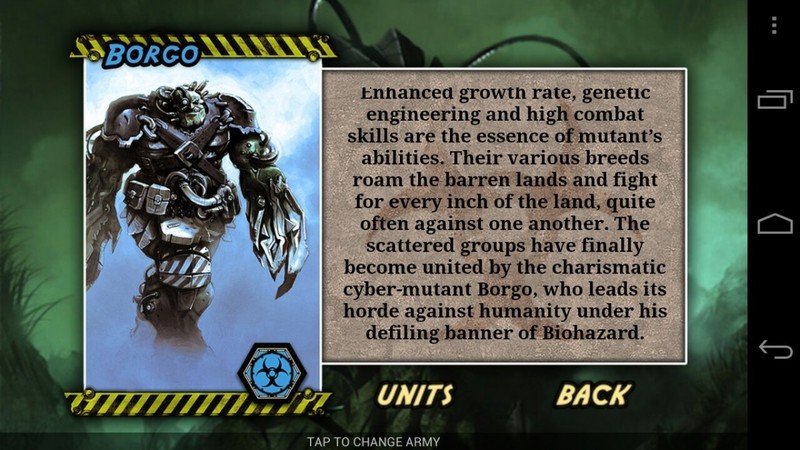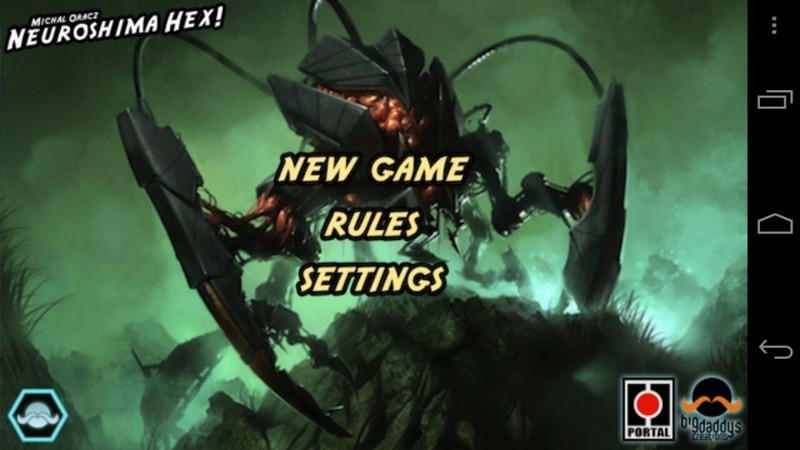Neuroshima Hex review - not your robo-mama's board game

Neuroshima Hex is a board game with a particularly unique sci-fi setting full of story, cyborgs, and strategy. It’s been on Android for a few months, but just recently enjoyed a much-needed stability update. The far future war game pits the scrappy armies of mankind against several factions, ranging from marauding mutants, well-equipped gangs, and the very mechanical menace that plunged the human race into anarchy hundreds of years ago.
The turn-based gameplay is a simple back-and-forth that’s punctuated by sparse (but dramatic combat), and a wide variety of units with special rules.
Graphics and audio
As an established board game, Neuroshima Hex has a lot of great original artwork and polished fiction to pull upon. Most units have some kind of artwork showcasing some gruesome creature with tank treads for legs or some badass warrior of the future.
Despite the excellent artwork, animations are extremely basic.It’s too bad, considering the high-tech subject matter; it’s easy to imagine some pretty great sound effects and visuals throughout combat and deployment. Likewise, sound effects are limited to the same dull thwak clip every time a unit does damage to another.
Gameplay and controls
The gameplay is pretty straightforward. The goal is to inflict as much damage on the opponent’s HQ unit - 20 to destroy it, if possible. Every turn, each player draws three hex cards and discards one. They then play cards representing various kinds of soldiers or instant action cards, which make their effect on play then are discarded. There’s local hotseat multiplayer, but no online, unfortunately.
Unlike a lot of card games, there isn’t combat every turn. It’s incited by a Battle card, whereby units make melee or ranged attacks in the direction (or directions) they’re facing. Attack order is based on initiative, and can be altered thanks to supporting units adjacent to attacking ones. Some units can take more than one hit, but most of them go down pretty quickly once the fighting starts. Even moving units takes its own instant action cards (unless a unit has mobility), so deciding positioning when playing a card is very important.
My biggest complaint is that it takes awhile to figure out which units to what. The notation on the hex cards tell most of the story (number of melee and ranged attacks, and in which direction), but at least half of the cards for any of the four factions have special rules that require a bit of familiarity. Unfortunately, there’s no way to easily see what a card does without pausing and tapping through three or four layers in the game menu. This could easily be circumvented with a mechanism that showed unit details simply by double-tapping them.
Get the latest news from Android Central, your trusted companion in the world of Android
There were some stability issues when digging through the units list; hitting back from the list resulted in a “stopped responding” error pop-up, though it didn’t force close the app or interrupt my game in any tangible way.
Pros
- Rich, gritty story and flavor
- Nuanced, deep gameplay
Cons
- Steep learning curve
Conclusion
Neuroshima Hex earns big points for originality, and once you get a good feel for what the cards can do, you can start thinking about strategy. That learning period could take awhile, depending on how much time you have to play, and if you don’t have it, the tactical nuances of the game may be lost on you. It would be great to see a tablet-optimized version of the game, but even as a smartphone title, board game fans will want to give this a shot. There’s a free version available for those unsure, or you can go ahead and take the plunge for $2.99.



